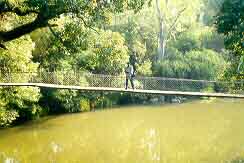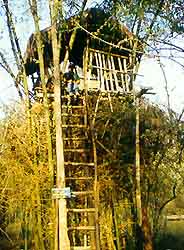| Wildlife
| |||||
Karnataka is blessed by some of the most bio-diversity rich habitats on the Indian subcontinent. Some of the better known wildlife reserves such as Nagarhole, Bandipur and Ranganathittoo are justifiably celebrated as heritage assets for future residents of Karnataka. But there are many lesser known natural havens that contain very endangered animals in Karnataka and these badly need public support. Take the case of the Free-tailed Bat. Found only in the Barapede Caves, located between Krishnapur and Talewadi in Karnataka s exquisite Bhimgad forests, these bats may be lost to the world even before they are properly studied. Insect-eating bats, their habitat is threatened by limestone miners, a dam across the Mahadeyi river and timber contractors. A wildlife conservation group called the Nature Lovers Club from Belgaum has been working very hard for some years now to prevent this area from being lost. After making numerous visits to the Bhimgad forests they have petitioned the Ministry of Environment and Forests at the Centre and have received the fullest possible support from the Minister, Mr. Suresh Prabhu, himself. |
More on Wildlife • Sanctuaries & Parks
Wild Escapes
Environment
Travelogues
| ||||
Unfortunately, this support
 has not yet percolated down to the very officers who are entrusted with the task of protecting the bio-diversity of Karnataka. When representatives went to the office of the Chief Wildlife Warden of Karnataka to ask that the bat be protected and the forests around the cave (which also house tigers, leopards and scores of other endangered species) be declared a sanctuary, they were shocked out of their wits. Expecting to be enthusiastically received by the Chief Wildlife Warden, they were disappointed. While he extended them every courtesy and spared a lot of time to talk to them, the sum and substance of his message turned out to be: We already have a lot of headaches with the existing sanctuaries and cannot afford to have one more. There are no tigers in the region. Every forest has some wildlife and that does not mean it should be protected. Bats are of no consequence whether they are there or not, does not matter, there are thousands of bats elsewhere in the country. It seems hard to believe that such a reckless and unthinking statement could emanate from this source above all others. has not yet percolated down to the very officers who are entrusted with the task of protecting the bio-diversity of Karnataka. When representatives went to the office of the Chief Wildlife Warden of Karnataka to ask that the bat be protected and the forests around the cave (which also house tigers, leopards and scores of other endangered species) be declared a sanctuary, they were shocked out of their wits. Expecting to be enthusiastically received by the Chief Wildlife Warden, they were disappointed. While he extended them every courtesy and spared a lot of time to talk to them, the sum and substance of his message turned out to be: We already have a lot of headaches with the existing sanctuaries and cannot afford to have one more. There are no tigers in the region. Every forest has some wildlife and that does not mean it should be protected. Bats are of no consequence whether they are there or not, does not matter, there are thousands of bats elsewhere in the country. It seems hard to believe that such a reckless and unthinking statement could emanate from this source above all others.
Ironically, Chart 6B of a Extinction stares many species in the face in India today, primarily on account of habitat destruction, coupled with poaching. Biologists around the world in fact estimate that within the next decade or two a wildlife holocaust will unfold since extinctions are taking place at a rate over 25,000 times the natural rate of extinctions prevalent on Earth before man. It seems we could lose almost 25 per cent of the 1.4 million species of plants and animals known to science. Some scientists believe that the loss of bio-diversity is a greater threat even than thermonuclear war. Apart from the loss of wild species, the issue also revolves around our food security as we depend, for instance, on just three species: wheat, rice and maize for over half the world's food! Without their wild relatives, disease could wipe out our food stock before we have time to react. The result would be mass starvation.
To support the initiative to have Bhimgad declared as a wildlife sanctuary, write to:
Nature Lovers Club, |
|||||
Editor: Romola Butalia (c) India Travelogue. All rights reserved. |
|||||

 Document titled A Framework for Identifying High Priority Areas and Actions for the Conservation of Tigers in the Wild lists the contiguous (or almost contiguous) forests of Dandeli, Anshi and Cotigao (within whose envelope Bhimgad is located) as critical tiger habitats. Page 29 of the document categorises the Dandeli-Bandipur belt as a Level I Tiger Conservation Unit (TCU) that requires a population status evaluation. The document in question has been almost five years in the making and has inputs from experts such as Dr. Ullas Karanth of the wildlife Conservation Society, USA. The purpose of such studies is to work towards the long-term survival of the tiger through the protection of connecting corridors capable of maintaining breeding populations of tigers.
Document titled A Framework for Identifying High Priority Areas and Actions for the Conservation of Tigers in the Wild lists the contiguous (or almost contiguous) forests of Dandeli, Anshi and Cotigao (within whose envelope Bhimgad is located) as critical tiger habitats. Page 29 of the document categorises the Dandeli-Bandipur belt as a Level I Tiger Conservation Unit (TCU) that requires a population status evaluation. The document in question has been almost five years in the making and has inputs from experts such as Dr. Ullas Karanth of the wildlife Conservation Society, USA. The purpose of such studies is to work towards the long-term survival of the tiger through the protection of connecting corridors capable of maintaining breeding populations of tigers.
 Those asking for Bhimgad to be saved are not some kind of wildlife fanatics. They point out that the forests between Dandeli and Cotigao probably contain several plants and insects that have not been recorded by science. They are also deeply concerned about the future of the people who live in these forests who they are confident will become the backbone of the entire effort to save Bhimgad. They insist that not one community should be displaced in the process of declaring the Bhimgad sanctuary. They have further asked the Ministry of Environment to convince the state government to divert funds from programmes such as the Employment Guarantee Scheme (EGS), Jawahar Rozgar Yojna (JRY) etc. to ensure that locals, employed for soil and moisture Conservation, work near their own villages.
Those asking for Bhimgad to be saved are not some kind of wildlife fanatics. They point out that the forests between Dandeli and Cotigao probably contain several plants and insects that have not been recorded by science. They are also deeply concerned about the future of the people who live in these forests who they are confident will become the backbone of the entire effort to save Bhimgad. They insist that not one community should be displaced in the process of declaring the Bhimgad sanctuary. They have further asked the Ministry of Environment to convince the state government to divert funds from programmes such as the Employment Guarantee Scheme (EGS), Jawahar Rozgar Yojna (JRY) etc. to ensure that locals, employed for soil and moisture Conservation, work near their own villages.